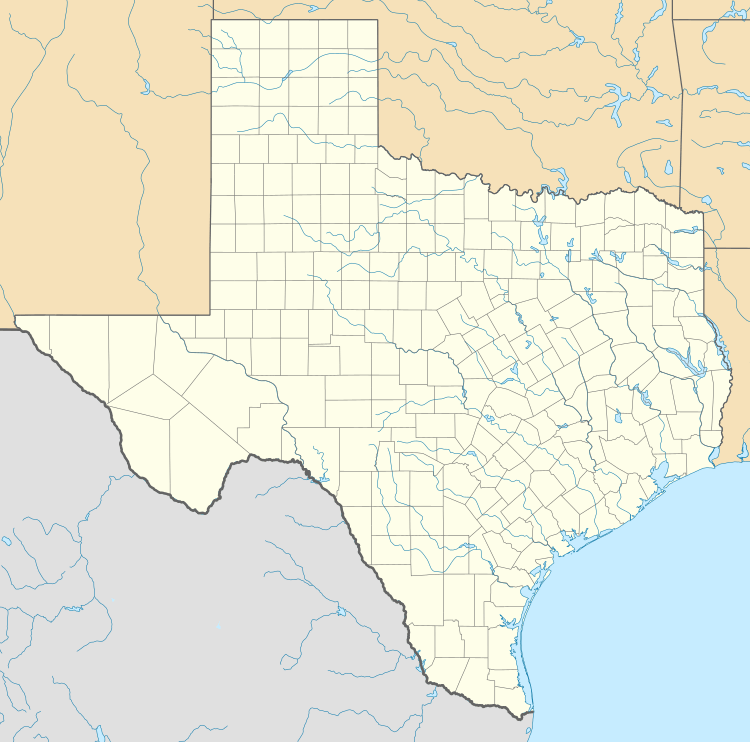Camp Ford
Camp Ford was a POW camp near Tyler, Texas, during the American Civil War.[1] It was the largest Confederate-run prison west of the Mississippi.[2][3]
| Camp Ford | |
|---|---|
| Near Tyler, Texas | |
 The Price Raid by Samuel J. Reader shows Union prisoners on the way to Camp Ford in October 1864 | |
 Camp Ford Location of Camp Ford | |
| Coordinates | 32°23′44.13″N 95°16′7.28″W |
| Site history | |
| Built | 1862 |
| Built by | |
| In use | 1862–1865 |
| Events | American Civil War |
| Garrison information | |
| Past commanders | Col. R. R. Brown |
History

Established in the spring of 1862 as a training camp for new Confederate recruits, the camp was named for Col. John Salmon Ford, a Texas Ranger and the Superintendent of Conscripts for the State of Texas.[4] The first Union prisoners to arrive at camp Ford in August 1863 included officers captured in Brashear City Louisiana in June, and included naval personnel captured when the 'Queen Of The West' and the 'Diana' were seized by the Confederate Navy. The captives were initially held in the open, but a panic ensued in November 1863 when 800 new prisoners threatened a mass breakout. A military stockade enclosing 4 acres (16,000 m2) was soon erected.[3]
With over 2,000 new prisoners taken in Louisiana on April 8 and 9 1864, at the battles of Mansfield, and Pleasant Hill, the stockade was quadrupled in size. Among those imprisoned there following these battles were 17 members of the 47th Pennsylvania Infantry, the only regiment from the Commonwealth of Pennsylvania to fight in the Union's 1864 Red River Campaign across Louisiana and the only regiment from the Keystone State to have men imprisoned at Camp Ford.[5] [6] With more prisoners captured in Arkansas, the prison's population peaked at about 5,000 in July 1864. The population was reduced by exchanges in July and October 1864,[3] and again in February 1865. The last 1,761 prisoners were exchanged on May 22, 1865.[2]
Landscape
Camp today
The original site of the camp stockade is now a public historic park, owned by Smith County, Texas, and managed by the Smith County Historical Society, a 501(c)(3) non-profit organization founded in 1959 by individuals and business firms dedicated to discovering, collecting and preserving data, records and other items relating to the history of Smith County. The park contains a kiosk, paved trail, interpretive signage, a cabin reconstruction, and a picnic area.[7] The camp is located on US Highway 271, .7 miles north of Loop 323 in Tyler, Texas. The geographical coordinates are: 32°23'44.13"N - 95°16'7.28"W
References
- House of Representatives: Report on the Treatment of Prisoners of War by the Rebel Authorities during the War of the Rebellion, page 199. Washington, Government Printing Office, 1869.
- "A Short History of Camp Ford". Smith County Historical Society, Tyler, Texas. Archived from the original on November 29, 2010. Retrieved March 21, 2011.
- Texas State Historical Society: Camp Ford. Retrieved August 18, 2010.
- Texas Beyond History, Camp Ford
- Snyder, Laurie. Red River Campaign (Louisiana, March to May 1864), in 47th Pennsylvania Volunteers: One Civil War Regiment's Story. Retrieved online, March 17, 2017.
- 47th Pennsylvania Volunteer Records, in Camp Ford Prisoner of War Database. Tyler, Texas: The Smith County Historical Society, 1864.
- Smith County Historical Society: Camp Ford.
External links
- Camp Ford Civil War Prison (video). Washington, D.C.: C-SPAN, March 12, 2018.
- Camp Ford Historic Park, C.S.A., in Texas Forest Trail. Nacogdoches, Texas: Texas Forest Trail Region and Texas Historical Commission, retrieved online August 4, 2019.
- Camp Ford Historic Site and Park (profile). Washington, D.C.: American Battlefield Trust, retrieved online August 4, 2019.
- Texas Beyond History: Camp Ford. Austin, Texas: Texas Archeological Research Laboratory at the University of Texas at Austin.
- Civil War Prisons, in CensusDiggins.com.
- The American Civil War; Prisoner of War Camps
